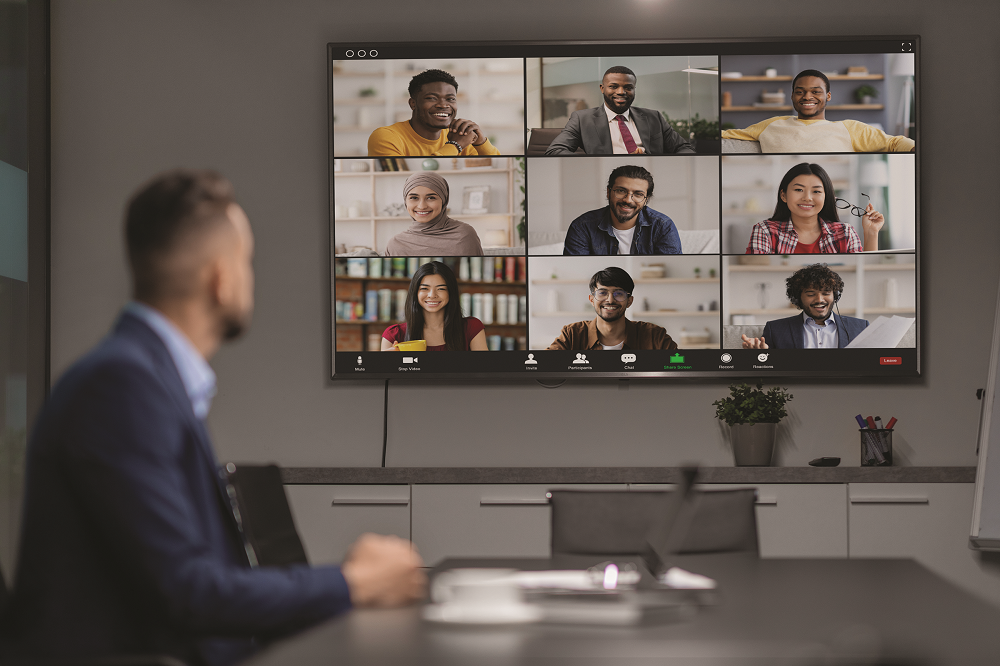When Nokia came out with its candy bar phone, it took the cell phone industry by storm. Nokia changed everything about the mobile phone and became the undisputed king of cell phones. That’s almost hard to believe in today’s age of the Apple iPhone. The iPhone completely changed how cell phones are used. In the conference room, a similar revolution is afoot. The new 21:9 hybrid-meeting-room projector is to hybrid-meeting rooms as the iPhone was to cell phones — transformative!
Hybrid meeting rooms are moving toward the 21:9 aspect ratio. When it comes to business projectors that will support this format, we don’t need another Nokia; we need an iPhone. In the past, meeting-room projectors didn’t need to deliver top-notch quality. Content was comprised primarily of simple text, bar graphs, spreadsheets and slideshows. If the blues and grays were a little off from the original or the presentation wasn’t super crisp, who cared? It didn’t inhibit understanding or productivity. It got the job done. It was the Nokia.
Today, meeting-room content is much richer, more complex — and active. Rather than simply presenting text or a slide deck, the screen displays feeds from videoconferencing, video, photographs, text, spreadsheets, chat boxes and more. Here, all of this content may be presented simultaneously. Everything is presented so the meeting feels more natural and equitable, no matter if you’re joining remotely or in person.
As the move toward 21:9 becomes the defining standard for hybrid meetings, it’s sparking other shifts as well. Just like the Nokia no longer cut it as a simple device that got one thing done, the meeting-room projector can’t simply fill the screen; it needs to enhance teamwork and collaboration with the high-quality reproduction and super high pixel density that meeting applications using the 21:9 format demand. Reproduction quality and accuracy of every piece of content onscreen is critical to that experience. This ensures that every piece of content is easily comprehended.
Pixel Density
Attendees need larger images for clarity and to help create the feeling of an in-person meeting, which the 21:9 format provides. However, the risk is that information on a large screen will be pixelated or unreadable with a standard business projector. This demands greater pixel density, which is the number of pixels per inch that yields the overall resolution.
How much pixel density is needed to support this format? It shouldn’t be surprising that it’s the pixel density we experience daily on our mobile devices and laptops. But replicating that richness is more than a WUXGA business projector is capable of within the 21:9 format. On a 130-inch screen, the pixel density of most WUXGA projectors is around 303 pixel per square inch (PPI2). To replicate the same high-res iPhone experience, a projector needs to reproduce content at four times that amount — 1,149 PPI2. At that level, all content — from small text of chat boxes to facial expressions — are clear and discernable to the entire room.
Color Accuracy
Whether projecting meeting attendees or color-specific marketing, creative, or scientific content, color accuracy is a critical detail. Color accuracy has mostly been a consideration for home cinema, theater, esports, and professional detail-oriented applications such as medicine and advertising. The best projectors and monitors in those markets have had a 92% or greater Rec.709 color coverage. Rec.709 color coverage expresses a device’s capability to reproduce color gamut. The more colors it can reproduce, the more accurate the content is depicted onscreen. With 92% Rec.709 color accuracy, participants’ skin tone and hair color appear clear and accurate, and other content is depicted as the creator intended.
HDR Support
For even better imaging, HDR is a must. HDR has typically been associated with cinematic reproduction. With HDR support, the projector is able to read and display content with HDR metadata, projecting video with accurate secondary colors and high pixel density that is as close as possible to the original.
Price Shift
Fortunately, this shift doesn’t come at an exorbitant cost. While extreme pixel density and accuracy were once confined to high-end projectors with steep $20,000 price tags, newer projectors have brought this level of quality within reach for businesses. Some of these are available for less than $4,500, which is a much more feasible price point for businesses needing to scale to multiple hybrid-meeting rooms.
As we navigate this new paradigm of hybrid meetings, it’s clear that the expectations for business projectors have changed dramatically. We no longer settle for mere screen-filling; we demand a level of clarity and richness that matches the complexity of the content being presented. The 21:9 format is not just a widescreen upgrade; it’s a symbol of a transformative era in collaborative technology, where the business projector is no longer just a tool but a catalyst for seamless and immersive communication. Just as the iPhone revolutionized cell phones, the 21:9 hybrid-meeting-room projector is redefining the way we meet, collaborate and innovate. It needs to look as good as possible.
Bob Wudeck serves as senior director, business development for BenQ, a global provider of visual display solutions.





